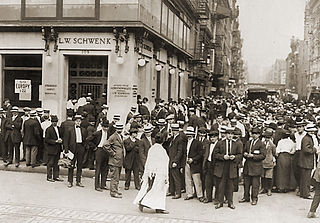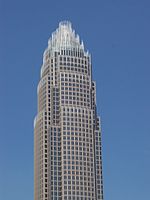
The Federal Deposit Insurance Corporation (FDIC) is a United States government corporation supplying deposit insurance to depositors in American commercial banks and savings banks. The FDIC was created by the Banking Act of 1933, enacted during the Great Depression to restore trust in the American banking system. More than one-third of banks failed in the years before the FDIC's creation, and bank runs were common. The insurance limit was initially US$2,500 per ownership category, and this has been increased several times over the years. Since the enactment of the Dodd–Frank Wall Street Reform and Consumer Protection Act in 2010, the FDIC insures deposits in member banks up to $250,000 per ownership category. FDIC insurance is backed by the full faith and credit of the government of the United States, and according to the FDIC, "since its start in 1933 no depositor has ever lost a penny of FDIC-insured funds".

In the United States, banking had begun by the 1780s, along with the country's founding. It has developed into a highly influential and complex system of banking and financial services. Anchored by New York City and Wall Street, it is centered on various financial services, such as private banking, asset management, and deposit security.

The savings and loan crisis of the 1980s and 1990s was the failure of 32% of savings and loan associations (S&Ls) in the United States from 1986 to 1995. An S&L or "thrift" is a financial institution that accepts savings deposits and makes mortgage, car and other personal loans to individual members.
A bailout is the provision of financial help to a corporation or country which otherwise would be on the brink of bankruptcy. A bailout differs from the term bail-in under which the bondholders or depositors of global systemically important financial institutions (G-SIFIs) are forced to participate in the recapitalization process but taxpayers are not. Some governments also have the power to participate in the insolvency process; for instance, the U.S. government intervened in the General Motors bailout of 2009–2013. A bailout can, but does not necessarily, avoid an insolvency process. The term bailout is maritime in origin and describes the act of removing water from a sinking vessel using a bucket.
United Commercial Bank was an overseas Chinese bank in the United States, based in San Francisco, California. It was a subsidiary of UCBH Holdings. Founded in 1974 as United Federal Savings and Loan Association, it changed its name to United Savings Bank, and finally United Commercial Bank in 1998. It had operations and branches located in the San Francisco Bay Area, Sacramento, Stockton, Los Angeles and Orange counties, New York, Boston, Greater Seattle Area, Hong Kong, Atlanta, Houston, Shanghai and two representative branches in Taipei, Taiwan and Shenzhen, China. United Commercial Bank was closed by regulators on November 6, 2009; it was the 120th U.S. bank to fail in 2009, and it had $11.2 billion in assets at the time of the bank failure. East West Bank of Pasadena, California, acquired all the deposits of UCBH.
Kerry Killinger is an American businessman and author. He is founder and CEO of Crescent Capital Associates, and previously served as chairman and chief executive officer of Washington Mutual from 1990 until 2008.

The early 1980s recession was a severe economic recession that affected much of the world between approximately the start of 1980 and 1982. It is widely considered to have been the most severe recession since World War II until the 2007–2008 financial crisis.
Penn Square Bank was a small American commercial bank located in Oklahoma City, Oklahoma. The bank made a large number of poorly underwritten energy-related loans that it sold to other banks. Losses on these loans led to significant financial problems in these banks. Penn Square Bank declared bankruptcy in July 1982.
IndyMac, a contraction of Independent National Mortgage Corporation, was an American bank based in California that failed in 2008 and was seized by the United States Federal Deposit Insurance Corporation (FDIC).

"Too big to fail" (TBTF) is a theory in banking and finance that asserts that certain corporations, particularly financial institutions, are so large and so interconnected that their failure would be disastrous to the greater economic system, and therefore should be supported by government when they face potential failure. The colloquial term "too big to fail" was popularized by U.S. Congressman Stewart McKinney in a 1984 Congressional hearing, discussing the Federal Deposit Insurance Corporation's intervention with Continental Illinois. The term had previously been used occasionally in the press, and similar thinking had motivated earlier bank bailouts.
Corus Bankshares, Inc. operated as the holding company for Corus Bank, N.A., a United States company that offered consumer and corporate banking products and services.

A bank failure occurs when a bank is unable to meet its obligations to its depositors or other creditors because it has become insolvent or too illiquid to meet its liabilities. A bank typically fails economically when the market value of its assets falls below the market value of its liabilities. The insolvent bank either borrows from other solvent banks or sells its assets at a lower price than its market value to generate liquid money to pay its depositors on demand. The inability of the solvent banks to lend liquid money to the insolvent bank creates a bank panic among the depositors as more depositors try to take out cash deposits from the bank. As such, the bank is unable to fulfill the demands of all of its depositors on time. A bank may be taken over by the regulating government agency if its shareholders' equity are below the regulatory minimum.
Silver State Bank was an American commercial bank based in Nevada that failed in 2008. The bank had 17 branches in the Las Vegas and Phoenix metropolitan areas and loan operations across the western United States. The bank's assets were acquired by Zions Bancorporation, a bank holding corporation with $2 billion in assets.
Guaranty Bank was a bank based in Milwaukee, Wisconsin. It had 119 branches, 107 of which were kiosks in grocery stores and Walmart Supercenters. The bank operated in five states: Wisconsin, Illinois, Michigan, Minnesota, and Georgia. The bank also operated locations under the name BestBank. On Friday, May 5, 2017, as a result of bank failure, the bank was shut down by the Office of the Comptroller of the Currency. It was placed into receivership and the Federal Deposit Insurance Corporation was named receiver. The assets of the bank were sold to First Citizens BancShares.
Guaranty Bank was a major bank based in Austin, which collapsed in 2009. It was formed in 1988 as part of Temple-Inland and in 2007 became a standalone company. At the time of its collapse, Guaranty was the second largest bank in Texas, with 162 branches across Texas and California, and had $13 billion in assets and held $12 billion in deposits. Major shareholders included billionaire investor Carl Icahn and hotel tycoon Robert Rowling, who jointly invested $600 million in the bank in 2008.
Urban Partnership Bank was a Federal Deposit Insurance Corporation, full-service community development bank in the United States with $1.4 billion in assets. It was established on August 20, 2010 when it acquired the deposits and some of the assets of ShoreBank from the FDIC. It was headquartered in Chicago, Illinois. After chronic losses, it was acquired on Jan 30, 2019 by Providence Bank & Trust.
A deposit insurance national bank is a temporary bank in the United States that is established by the Federal Deposit Insurance Corporation (FDIC) in the wake of a bank failure under the Banking Acts of 1933 and 1935.








